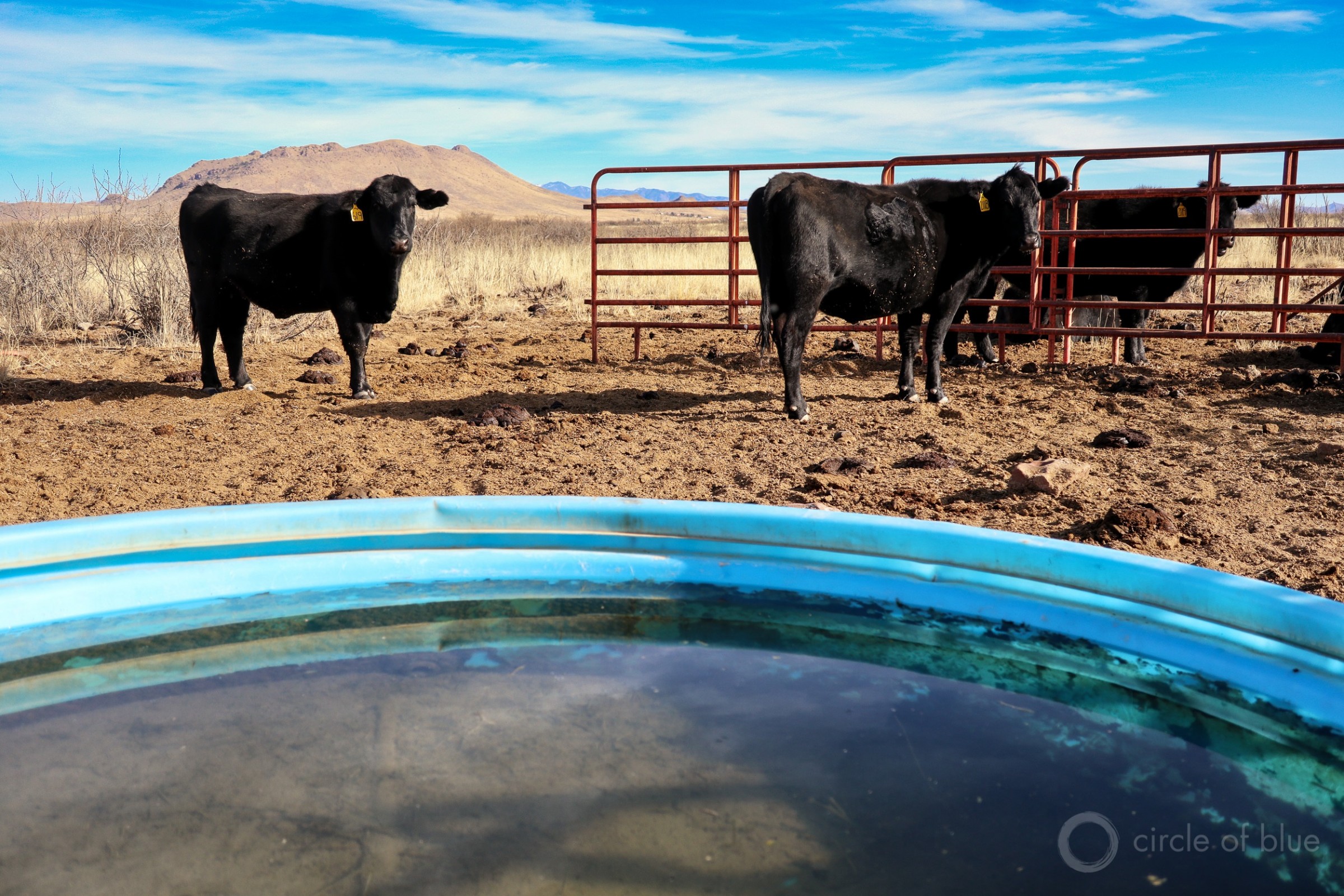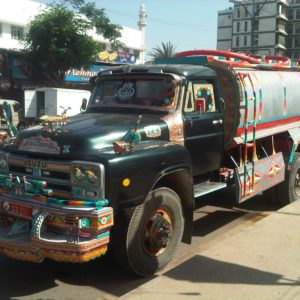Groundwater regulation, legal rights to clean water, and spending measures highlight this election cycle.

A surge of groundwater pumping by thirsty livestock, pecan, and pistachio farms has caused irrigation and homeowner wells to go dry in Cochise County, in southeast Arizona. Photo © Keith Schneider / Circle of Blue
By Brett Walton, Circle of Blue – October 26, 2022
Weeks before the November 8 election, national political debate centers on control of Congress.
In rural southeastern Arizona, however, the kitchen table issue strikes closer to home. Voters in parts of Cochise and Graham counties will decide whether to join the state’s more populated districts and regulate groundwater extraction. Orchards, vineyards, and dairy farms have moved into this dusty corner of Arizona where large-scale irrigation has caused drinking water wells to go dry and the land to subside, damaging highways.
“It’s pretty intense right now,” Rebekah Wilce told Circle of Blue about the campaign. Wilce is the treasurer of Arizona Water Defenders, the political action committee that brought the question to the ballot.
For Wilce and other campaigners across the country, these are the final, furious days in an effort to sway voters and influence the course of public policy.
Election season always features environmental ballot initiatives and referendums. This year is no different.
In California and New York, voters will be asked to approve multibillion-dollar bond and taxing measures to benefit air, land, and water. Such measures generally attract broad public support. Time and again, voters in states nationwide have been willing to borrow money and tax themselves to pay for clean, reliable water.
While state-level decisions this year are about money, local initiatives focus on law and policy. Besides the Arizona counties considering groundwater regulation, a Florida town and five Wisconsin counties will be voting on whether people should have a legal right to clean water. Those votes reflect a burgeoning movement in the country to secure environmental protection through changes in foundational legal documents.
State Spending
It is a relatively lean year for state-level water initiatives. In New York, the big-ticket item is a $4.2 billion bond measure to respond to the consequences of climate change.
The Environmental Bond Act would authorize the state government to borrow that amount of money and spend it on projects to remove old dams, buy out flood-prone properties, improve water quality, conserve land, restore wetlands, and plant trees in cities. Thirty-five percent of the funds are designated for low-income districts and communities of color burdened by pollution.
It is the state’s first environmental bond measure since 1996, and it comes a year after New Yorkers voted to amend the state Constitution to include the right to clean air, clean water, and a healthful environment.
An even larger spending proposal is at stake in California, where voters will weigh the merits of Proposition 30.
The taxing measure would establish a trust fund within the state treasury for electric vehicle infrastructure and fighting wildfires. The money would come from a 1.75 percent tax increase on the share of personal income that is above $2 million.
The state estimates that the tax would bring in $3.5 billion to $5 billion annually.
Several state agencies would have a hand in administering the funds. Thirty-five percent would be overseen by the California Energy Commission for the purpose of building out electric vehicle charging stations. Forty-five percent would be managed by the California Air Resources Board to provide rebates, loans, and grants that bring down the cost of electric vehicles for low-income households. The remaining 20 percent would go to Cal-Fire, for suppressing and preventing extreme wildfires that burn homes, take lives, and destroy watersheds.
Local Regulation
Those are the state-level entries. The local initiatives are more intimate, reflecting problems that many voters will be able to see or touch.
Initiatives at opposite ends of the country — and in places with contrasting climates — are attempts to reckon with the use and abuse of water and land.
For voters in the two Arizona counties, the decision amounts to a simple question: do they wish to regulate groundwater use in the Willcox and Douglas basins? Willcox basin spans parts of Cochise and Graham counties. Douglas basin is entirely in Cochise County.
The legal tool for groundwater regulation in Arizona is called an Active Management Area, a state policy that originated in 1980, another time when excessive groundwater use was a prominent political issue. There are five AMAs already in the state, mostly in the corridor from Phoenix to Tucson. Only residents who live within the Willcox and Douglas basins will be allowed to vote on the AMA, which would be overseen by the state.
AMAs in the two basins are intended to prevent further declines in the area’s groundwater. As agriculture expanded in southeast Arizona in the last two decades, household wells have gone dry and the land began to sink where groundwater extraction was most intensive. Establishing an AMA would put a brake on new large-volume irrigation, but there are some exceptions. Existing wells, if they have been used in the previous five years, would be grandfathered in. Land that is currently being developed could also apply for water. Household wells — those that pump 35 gallons per minute or less — would be exempt from the rules.
Agribusiness — the Arizona Cattle Growers Association, the Arizona Wine Growers Association — opposes the measure on the grounds that it removes local control. They prefer to rally around projects that would corral rain and funnel it into the distressed basins.
New legal tools are also the objective of campaigners in a city along Florida’s Atlantic Coast. Voters in Titusville will decide whether to grant themselves the right to clean water.
Forty miles east of Orlando and home to 48,000 people, Titusville abuts Indian River Lagoon. The 156-mile-long lagoon is troubled by frequent toxic algal blooms linked to nutrient pollution from farms, septic tanks, and wastewater plants. The blooms turn the water a sickly, cloudy green and they prevent sunlight from reaching seagrass beds that are the primary food source for manatees. As the seagrass dies, so have the manatees. Hundreds of Indian River manatees perished in the last two years, an ecosystem collapse that pains Michael Myjak.
“I’ve watched this lagoon die over the last 35 or 40 years,” Myjak told Circle of Blue. He sees waterways wrecked from sewage spills and development. “There’s no place to go swimming anymore,” he added. “The local environment is in free fall.”
Myjak, a retired rocket scientist, is the president of Speak Up Titusville, the group campaigning to amend the town charter to include a right to clean water.
Myjak said the Titusville initiative was influenced by a similar group in Orange County, where 90 percent of voters approved a charter amendment in 2020 to grant legal rights to the county’s rivers. That amendment has been stymied in court and preempted by the state Legislature, which passed a law to invalidate local measures to grant rights to nature.
Learning from that experience, Myjak said his group was careful with the wording of the Titusville charter amendment. It grants the rights of clean water not to nature but to people.
Campaigners hope Titusville is an opening act. Signature gatherers are fanning out across Florida in support of a statewide movement. The Florida Rights of Nature Network wants to amend the state Constitution to establish a right to “clean and healthy waters.” The group is angling for a spot on the 2024 ballot.
These right to clean water amendments — like the one that New Yorkers passed in 2021 — are gaining momentum. Just look north.
Should Wisconsin establish a right to clean water? In five Wisconsin counties — Adams, Bayfield, Green, Juneau, and Outagamie — voters will answer ‘yes’ or ‘no’ on November 8. Though it is a non-binding vote, the outcome is more than symbolic, says Johnson Bridgwater, water advocates organizer for River Alliance of Wisconsin, which is supporting the local campaigns. He says the vote will be an indication of public sentiment in a state where groundwater is being polluted by farms, dairies, and industries.
“The intention is to send a very clear message that Wisconsinites want clean water to be elevated as a more important issue,” Bridgwater told Circle of Blue.
Five Wisconsin counties have already held advisory votes in the last year. By large margins, voters in all five said ‘yes’ to the clean water amendment.
Brett writes about agriculture, energy, infrastructure, and the politics and economics of water in the United States. He also writes the Federal Water Tap, Circle of Blue’s weekly digest of U.S. government water news. He is the winner of two Society of Environmental Journalists reporting awards, one of the top honors in American environmental journalism: first place for explanatory reporting for a series on septic system pollution in the United States(2016) and third place for beat reporting in a small market (2014). He received the Sierra Club’s Distinguished Service Award in 2018. Brett lives in Seattle, where he hikes the mountains and bakes pies. Contact Brett Walton





